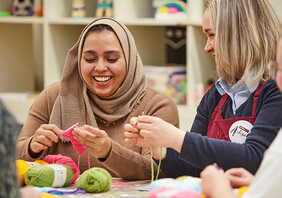How to Make Bunting
No gathering would be complete without a little bit of bunting! This is a great project for beginners to try their hand at, you'll have yourself metres of bunting fit for any party in no time at all!
Get creative, mix colours and patterns to suit your party theme or colour scheme in your house! Follow our super simple tutorial and get making...
Project and instructions by Caroline Giles
You will need
How to make
* Pins
* Pencil
* Dressmaking scissors
* Tape measure
Optional:
* Sewing machine
* Pom pom trim

Measure two 20 centimetre width strips of fabric.
With right sides together measure and mark with a fabric pen at 22 centimetre intervals along the bottom edge of the fabric.
Along the top edge make the first mark at 11 centimetres and then continue along the top at 22 centimetre intervals.



With right sides together and leaving a 1 centimetre gap at the top of the flag, feed the trim in between the fabric triangles, ensuring the pom poms are facing inwards.
Carefully stitch along both diagonal edges making sure you have caught the trim as you go. When you get to the tip of the flag make sure the needle is down and feed the trim around the trim to create a nice point. Then continue sewing leaving 1 centimetre at the end.


When you have sewn your flag turn it the right way and press to get nice crisp edges.
When you have made all your flags sandwich them between the bias binding and pin to your bias binding. Continue pinning the flags leaving 5 centimetre intervals between each one.
Carefully sew the bias binding making sure the you are catching both sides.
Now you have a gorgeous bunting to display with pride!














